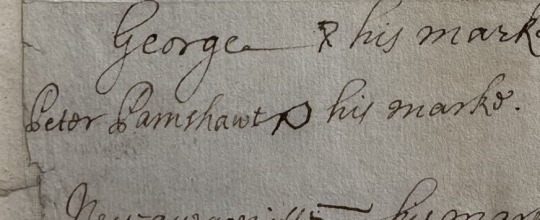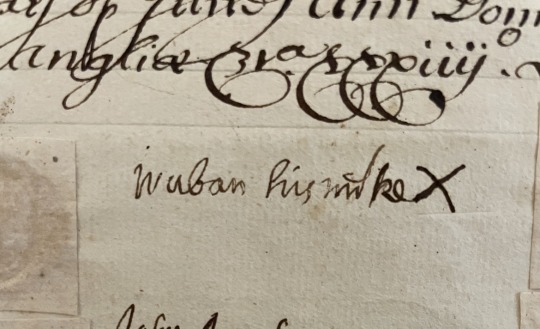#KingPhilipsWar
Explore tagged Tumblr posts
Text

Awashonks. Awawsuncks. Her Mark.
Sachem of the Sakonnet. Her home there, near Narragansett Bay and Patuxet, in and around the place known today as Little Compton, Rhode Island. Created a hopeful alliance with colonizers at Plimoth to spare her people from enslavement during and after King Philip’s War. Endured the dispossession of lands and several attempts by colonizers to usurp her role as leader at Sakonnet.
Some of her kin (also appearing on this document): Samponock (alias Amos), Wawwooyowwitt, Soonchas (identified as her son). Names spelled as they appear.
This deed for Sakonnet land, signed May 23, 1674. Seen @ Massachusetts Historical Society.
#sakonnet#wampanoag#awashonks#hermark#theirmarks#easternwoodlands#nativehistory#sachem#17thcentury#17c#rhodeisland#masshistorical#algonquian#wawwooyowitt#soonchas#samponock#kingphilipswar
2 notes
·
View notes
Text
The true story of Thanksgiving weaves together a tapestry of complex historical events, revealing both moments of unity and tragic conflicts that have shaped the American experience.
#AmericanHistory#BattleofTippecanoe#CivilWar#Conflict#Gratitude#HistoricalComplexity#KingPhilipsWar#NationalHoliday#PequotMassacre#Pilgrims#Thanksgiving#Unity#Wampanoag#Warof1812#frnwh
1 note
·
View note
Link
In "Mayflower: A Story of Courage, Community, and War," author Nathaniel Philbrick writes about how Native Americans and English Americans co-existed in a process of give and take during the early settlement years after the Pilgrims arrived in New England, but decades later found themselves in the middle of a deadly war. This second discussion with the author about the book took place on a 2007 episode of "Conversations On The Coast with Jim Foster" originating in San Francisco, California. Photo: nathanielphilbrick.com
#authorinterview#book#coc#conversationsonthecoast#indians#jimfoster#kingphilipswar#mayflower#milesstandish#nathanielphilbrick#nativeamericans#newengland#pilgrims#plymouthharbor#reading#sanfrancisco#sf#thanksgiving#uscolonialperiodhistory#usstate&localhistory
0 notes
Photo

August 17th, 1675
I can't believe those wretched Indians had the audacity to attack us. Who do they think they are? We are here for good and nothing they can do will change it. Do they really think that they can beat us on our own land? Those imbeciles! I don't even know how my parents dealt with these Indians. Gosh they are so annoying. If there is no fur then why do we need to give them our goods. The entire point of trading with them is that we get their fur and they get our weapons. Am I right or am I right? King Philip is going to be the reason that his “precious” tribe is annihilated. But who really cares. Let's be honest they are a waste of space anyways and it's not our fault that they have nothing to trade anymore. I’ll keep you guys updated on how all of this turns out (we are definitely going to win) and until next time...
-Sir Archibald Thornton
Update: August 25th, 1676
One of my friends told me that King Philip was beheaded. Finally! But I know our victory is a sign of God’s favor. If anyone knows where I can get the leftover Indians let me know. You can never have too many servants. Talk to you guys later.
-Sir Archibald Thornton
1 note
·
View note
Photo

Sometimes you come across something magical #inthestacks that you never saw before. This morning I found this hymnal described as the first published music written by a Native American author. Thomas Commuck, a #narragansettindian born in Rhode Island in 1805, settled in Wisconsin after marrying a Pequot woman. There he wrote this unusual Christian hymnal in which he assigned each song a title of an Indian tribe, place or chief. Shown below the title page is Hymn 422 "Canonechet" dedicated to the Narragansett sachem during King Philip's War and the Great Swamp Fight and who was put to death by the English colonists after spurning an offer of peace. Commuck beautifully assigns this hymn to him which reads: "Peace be on this house bestow'd, Peace on all here that reside; Let the unknown peace of God With the man of peace abide!" #narragansett #rhodeisland #rhodeislandhistory #nativeamerican #nativeamericans #sacredmusic #hymns #kingphilipswar (at Providence Public Library)
#rhodeisland#inthestacks#narragansettindian#narragansett#kingphilipswar#sacredmusic#rhodeislandhistory#hymns#nativeamericans#nativeamerican
0 notes
Photo

Playing young Margaret Sanford, future wife of Royal Governor of Massachusetts Thomas Hutchinson. Speaking at Smith’s Castle’s event, Bridges to the Past, on Miss Sanford’s ancestry and their involvement in King Philip’s War.
#kingphilips#kingphilipswar#King Philip's War#1675#Sanford#governors#Massachusetts#Rhode Island#rhodeisland#massachusettshistory#massachusetts history#margaret sanford#thomas hutchinson#thomashutchinson#margaretsanford#margaretsanfordhutchinson#maragaret sanford hutchinson#hutchinson#hutchinson family#Smithscastle#smithcastle#smith's castle#bridgetothepast#bridge to the past#1700s#french and indian war#1754#rhodeislandhistory#rhode island history#history
0 notes
Text

the mark of Josoph Robon
Joseph Robin, Nipmuc. At home at Chaubunagungamaug (present day Webster, Massachusetts) and Hassananamisco (present day Grafton, Massachusetts). Joseph Robin was the son of Petuhansit, or Old Robin, and is known to have switched allegiances during King Philip’s War, from informing for the Colonizers to joining Metacom and fighting against them.
Joseph Robin’s mark appears here, with other Nipmuc signers, on an agreement to the sale of land between Hassanamisco and Magunkaquog. Magunkaquog is the place now occupied by towns lying between Grafton and Natick, including Ashland and Westborough.
Document is undated. Seen at the Massachusetts State Archives.
#josephrobin#petuhansit#nipmuc#hassanamisco#chaubunagungamaug#magunkaquog#kingphilipswar#theirmarks#17thcentury#17c#algonquian#easternwoodlands#nativehistory#massachusetts#massstatearchives
1 note
·
View note
Text

Sampoonock alias Amos his marke
Wampanoag. The son of Awashonks, great Sachem or Saunkskwa at Sakonnet. Samponock’s homelands on the east side of Narragansett Bay, across from Aquidneck Island, and in and around the place known today as “Little Compton, Rhode Island.” In this document, Samponock and his family (listed below) are identified as “chief Sachems of Succonot and parts adjacent…”
Sampoonock (also spelled Samponack)’s kin, with names spelled as they appear in the document itself: his mother, “Awawshonks.” His father “Wawwooyowwitt.” A brother, “Cunckochowitt alias Symon.”
Alternative name spellings include Awashonks, Wawayeenit and Cakawehunt, respectively.
This deed, for Sakonnet land, signed May 23, 1674. Seen at the Massachusetts Historical Society
#sakonnet#wampanoag#samponack#sampoonock#hismark#theirmarks#easternwoodlands#nativehistory#sachem#17thcentury#17c#rhodeisland#masshistorical#algonquian#littlecompton#wawayeenit#cakawehut#kingphilipswar
0 notes
Text

Androw Pitteme his mark (Andrew Pittimee, Pittomo or Pittame)
Nipmuc. At home in and around Natick. A “Christian Indian,” members of Pittimee’s family including several children murdered by four white settlers in the massacre at Hurtleberry Hill, in 1676, in the midst of the First Indian War, or King Philip’s War. Pittimee was interred on Deer Island (and survived) also in 1676. Following the War, Pittimee appears across several land transfer documents across Nipnet (Nipmuc country) and acts as an interpreter and counselor to Waban and other Nipmucs.
Pittimee’s mark appears here on a deed for land at Towtaid, or so-called Leicester, Massachusetts. Signed January 27, 1686.
Seen at the American Antiquarian Society.
We have previously shared another document with Pittimee’s pictograph signature, from a deed for land at a place today called Sherborn, Massachusetts, dated June 20, 1682.
#nipmuc#pittimee#andrewpittimee#towtaid#leicestermass#theirmarks#easternwoodlands#nativehistory#17thcentury#17c#massachusetts#waban#americanantiquariansociety#algonquian#kingphilipswar
0 notes
Text

Peter Pamshawt his marke.
Presumably Wampanoag and kin to Awashonks, whose homelands at Sakonnet include the place today called “Little Compton, Rhode Island.”
Peter Pamshawt’s name appears here alongside many others as co-signatories to a document dated May 23, 1674. The document, principally signed by Awashonks, details the dispossession of land from Sakonnet to white settlers.
So far, we’ve uncovered little-to-no additional information about Peter Pamshawt to be able to further contextualize his life. If you know more, feel free to share in the comments!
#peterpamshawt#pamshawt#sakonnet#wampanoag#awashonks#hismarke#theirmarks#easternwoodlands#nativehistory#17thcentury#17c#rhodeisland#masshistorical#algonquian#kingphilipswar
1 note
·
View note
Text

Piambo. Pyambow. Piamboho. Piambowhow. His Mark.
Nipmuc. His home at Hassanamesit (present day Grafton, MA and surrounding areas) and later at Natick. Interred on Deer Island during the First Indian War (King Philip's War). Leader in praying town at Natick, with Waban. Translator for John Eliot.
His mark appearing on deeds relative to land transfers and land disputes against settlers in Nipmuc country.
This deed, for land at a place today called Sherborn, Massachusetts, marked on June 20, 1682. Seen @ Massachusetts Historical Society.
#piambow#nipmuc#natick#hassanamesit#waban#theirmarks#hismark#massachusetts#17thcentury#17c#masshistoricalsociety#algonquian#deerisland#firstindianwar#easternwoodlands#nativehistory#kingphilipswar
0 notes
Text

Miswaban. Waban. His Mark.
His homes at Nonamtum (present day Newton) and Natick, at the confluence of Nipmuc and Massachusett homelands. Probably born at Musketaquid, near present day “Concord, Massachusetts.” Primary records and contemporary research both confuse and misidentify(?) his tribal identity. Active as a leader in various Praying Towns in Massachusetts. Despite this, Waban and his family were interred at Deer Island during the First Indian War (or King Philip’s War). Contested the “sale” of some lands in and around Natick. Died 1684.
The Algonquian word waban can be translated to the English word for wind.
Some kin: a partner, called Tasunsquaw, their son, Weegramomenit or Thomas.
This document signed June 12, 1682. Seen @ Massachusetts Historical Society.
#massachusett#natick#nipmuc#nonantum#hismark#theirmarks#easternwoodlands#nativehistory#17thcentury#17c#massachusetts#waban#masshistorical#algonquian#weegramomenit#tasunsquaw#deerisland#kingphilipswar
0 notes
Text
Philbrick: Mayflower: A Story of Courage, Community, and War
#authorinterview#books#coc#conversationsonthecoast#englishcolonists#jimfoster#kingphilipswar#mayflower#nathanielphilbrick#nativeamericans#newengland#philbrick#pilgrims#plymouthrock#reading#sanfrancisco#sf#thanksgiving#unitedstateshistory#uscolonialhistory
0 notes